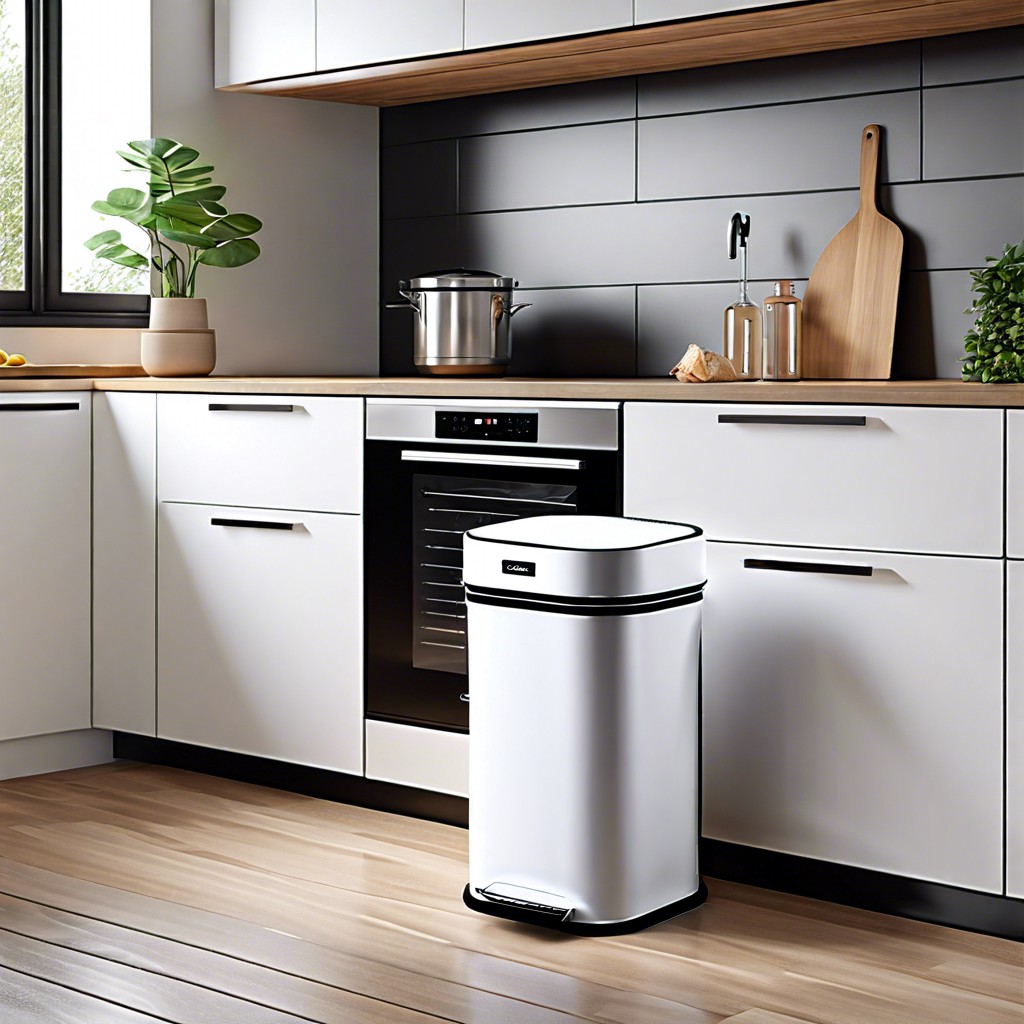Last updated on
Discover the ideal size for a kitchen trash can to fit your space and needs with our practical guide.
Key takeaways:
- Kitchen trash can sizes range from 7 to 13 gallons.
- Consider household waste volume and frequency when choosing a size.
- Choose trash bag sizes based on the capacity of your trash can.
- Consider the material and durability of the trash can.
- Recommended sizes: 7-10 gallons for singles, 12-16 gallons for couples, and 20-30 gallons for families.
What's Inside
Standard Dimensions of Kitchen Trash Cans

Picture this: You’re setting up your cozy kitchen, and the choice of a trash can size is next on your to-do list. Generally, you’ll find that kitchen bins range from petite 7-gallon sizes perfect for the minimal waste producer up to 13 gallons for the average household. It’s like choosing a sidekick for your daily clean-up adventures – size does matter.
These dimensions are more than just numbers; they’re about the daily dance around the kitchen. A compact 7-gallon bin slides in effortlessly under the sink, making it the go-to for space savers. Meanwhile, the 10 to 13-gallon bins are akin to kitchen centurions, standing around 23 to 25 inches tall. They’ll handle a family’s worth of scraps without flinching, demanding only an occasional emptying to carry on.
So, when you scan the home store aisles, keep in mind how much space you’re willing to spare. And remember, while your bin needs to be practical, it doesn’t have to be a dull part of the decor. With modern design options, your trash can easily become the undercover agent of style in your kitchen.
Capacity Considerations for Household Waste
When choosing a kitchen trash can, think about how much waste your household generates daily. A smaller family or those who recycle and compost extensively might skate by with a 7–10 gallon can. Singles or couples fall nicely in this capacity range, striking a balance between frequent emptying and not letting waste sit too long.
However, larger families or avid cooks can fill a bin in no time. For them, a 12–16 gallon can is a smart move. It reduces the chore of taking out the trash to a manageable few times per week.
Then there’s the feast or famine consideration: if you host dinner parties or holiday gatherings, a larger-than-usual can prevent trash overflow from turning your merry event into a game of Tetris with waste.
Remember, choose your size based on volume and frequency of disposal, balancing the need for capacity with the available space in your kitchen. Too big, and it’s an unwieldy kitchen occupant; too small, and it’s a constant nuisance. Like Goldilocks, aim for just right.
Compatibility With Trash Bag Sizes
Navigating the world of trash bags can be a bit like finding a needle in a haystack—confusing and time-consuming. But here’s the scoop: the size of your kitchen trash can predetermines which bags you’ll be hunting for on store shelves.
A snug fit is the goal. Too small, and you’ll be wrestling the bag into the can; too large, and it’s an awkward drape and tuck situation. Most trash can manufacturers are in sync with bag producers, making this less of a mix-and-match puzzle.
For a standard 13-gallon kitchen trash can, you’re likely eyeing bags labeled “13-gallon.” It feels a bit like a “Captain Obvious” situation, but hey, clarity is king. Smaller bins around 7 to 10 gallons fit into the “tall kitchen bag” category, typically sans hassle.
On the flip side, if your can boasts a 20-30 gallon capacity—we’re talking the big leagues now—you’ll be browsing for corresponding labels. Remember: the numbers game isn’t arbitrary when it comes to bags. They’re the unsung heroes that keep the mess contained and your sanity intact.
Material and Durability: Weighing in On Size Choices
When considering what your kitchen trash can is made of, think about the long haul. Stainless steel bins might make your wallet wince initially, but their resistance to wear and tear is like a superhero’s armor against a daily barrage of kitchen waste. Plus, they’re a breeze to clean; a quick wipe is often all they need to keep shining.
Plastic cans, on the other hand, are the lightweights of the litter world. Their affordability makes them a hit, but mind that they can absorb odors like a sponge after a spill. However, they’re often the chameleons of the kitchen, available in a spectrum of colors to match any décor.
Now, size does matter, and in the case of materials, sometimes bigger isn’t always better. A large metal can might turn into a cumbersome kitchen companion, while a sleeker plastic model could be just the fit for a cozy space.
Consider the tug-of-war between size and material carefully. A choice that’s a tad too large could mean wrestling your can through narrow alleyways in your kitchen, while a diminutive option may see you taking out the trash more often than you’d like. Balance is key – find a material that’s tough enough to handle kitchen chaos without taking over your space.
Recommended Sizes for Single, Couples, and Family Homes
Living solo? A can that holds 7-10 gallons is ample, tucking away easily and aligning with your less frequent disposal needs. For those days when takeout wins over cooking, you won’t be drowning in unnecessary space.
Couples often find a sweet spot with 12-16 gallons. Juggling meal prep scraps and everyday rubbish, this size avoids the daily takeout, yet doesn’t overstay its welcome with a cumbersome footprint.
Families juggle more, from cereal boxes to a parade of milk jugs. Investing in a 20-30 gallon behemoth curbs the constant emptying chore. It’s the Goldilocks of trash cans for the bustling home: just right in tackling the refuse of daily life, keeping a busy kitchen streamlined.




